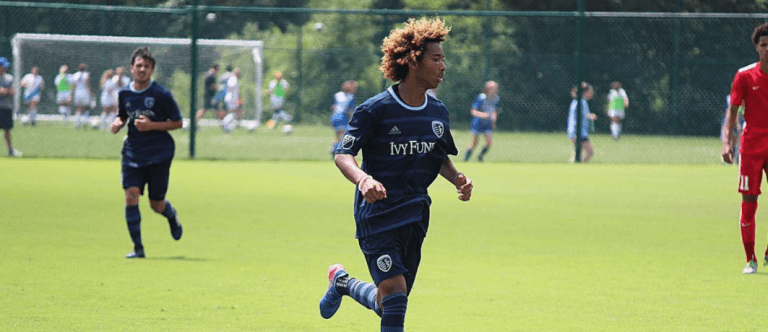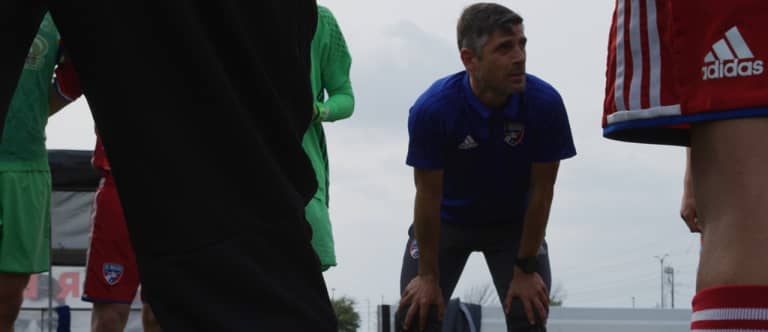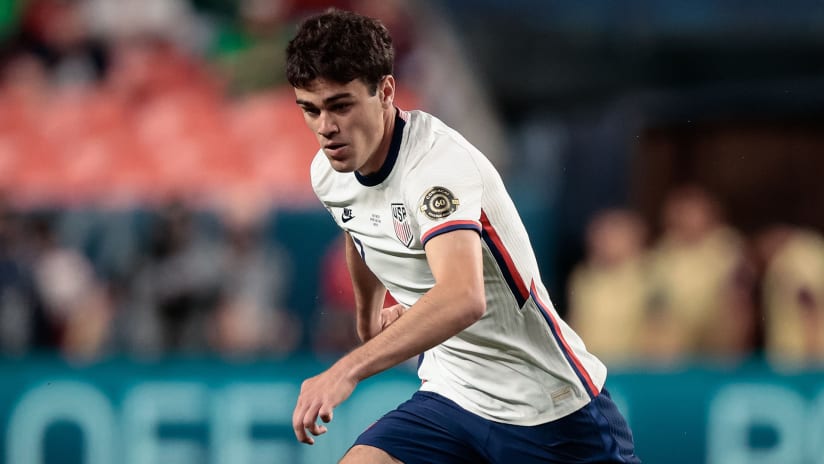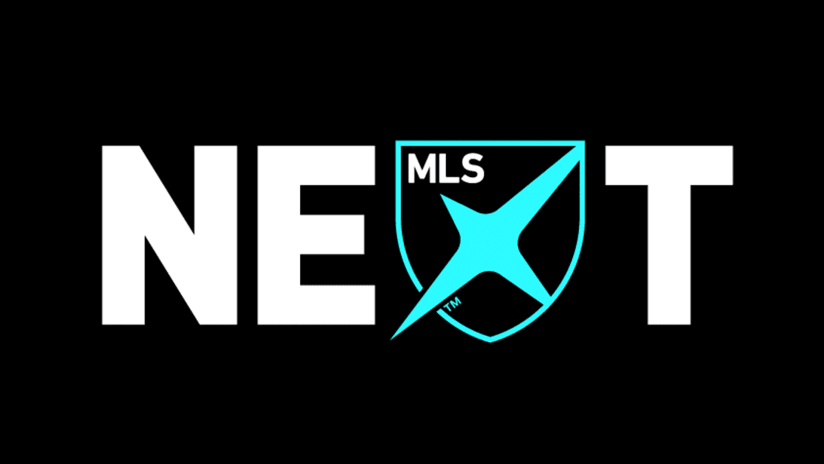He wasn’t yet old enough to drive, but even at 14, Jaylin Lindsey knew he needed to find a new road if he wanted to reach his full potential as a soccer player.
It was 2014, and Lindsey was receiving regular call-ups to the US Under-14 national team. The camp invites were nice, but Lindsey wasn’t getting the feedback he wanted from national team coaches. He had plenty of potential, but it was taking him the first few days of each camp to get up to speed with teammates like Tim Weah, Josh Sargent, Andrew Carleton and Chris Durkin. The staff worried that he wasn’t at a competitive enough club back home.
Desperate to not fall behind, Lindsey decided to take control of his development path. He started shopping around for academies, searching for a team that could accelerate his growth and put him on a road to the pros. After some research, he decided he wanted to join Sporting Kansas City.
The only problem? He lived in Charlotte, N.C., nearly 1,000 miles from Children's Mercy Park.
Lindsey didn't know if he’d be able to join SKC’s academy, but he was determined to give it a shot. His mom cold-called the club, connecting with academy director Jon Parry. Parry knew of Lindsey from his time with the US U-14s and was eager to bring him in. Lindsey was ready to make the jump, sight unseen. Not long after his mom’s first conversation with Parry, the teenager left Charlotte and his family, settling with a host family in the Kansas City suburbs and joining the SKC academy in January 2015, a few months shy of his 15th birthday.
Less than a year and a half later, in May 2016, he became the first American born this century to appear in a professional match when he debuted for SKC’s USL squad, Swope Park Rangers. Last September, while still only 17, he graduated to MLS and signed a Homegrown deal with the Sporting KC first team.

Jaylin Lindsey is a regular on Sporting KC's 18-man rosters in 2018. | Courtesy of Sporting KC
Now an 18-year-old US Under-20 international, Lindsey has made the bench in 10 of SKC’s 11 matches this year but has yet to make his MLS debut. He still has some ways to go to hit his ceiling, but his path is indicative of a growing trend of MLS teams welcoming, scouting and recruiting youth talent from outside of their own Homegrown territories.
“Pretty much all the MLS teams are doing this now,” Parry told MLSsoccer.com in a recent interview. “Everybody’s doing the same thing. This has become like recruiting for college.”
It doesn’t match perfectly with the romantic idea of a local kid falling in love with his hometown MLS club, working his way through their academy and eventually signing with the first team, but the nature of the league’s Homegrown rules and the sheer size of the US and Canada make out-of-territory academy recruitment a reality.
Every MLS team is given a defined Homegrown territory. For teams in big markets like New York or LA, that territory is as small as the 75-mile radius around their home stadium. For smaller-market clubs like Kansas City, Portland or Real Salt Lake, the territory includes multiple states. Even with certain clubs owning Homegrown rights in huge geographic regions, there are still plenty of areas – like North Carolina – where no MLS teams have rights. It’s these open areas where academy recruitment is heaviest.
SKC are at the forefront of the wave of out-of-region academy recruitment. Lindsey created something of a domino effect for the club in North Carolina, with Greensboro native Gianluca Busio, 15, following his older counterpart into the SKC academy and signing a Homegrown deal last August, one month before Lindsey inked his contract.

Gianluca Busio is one of the players SKC has recruited from outside the club's market | Courtesy of Sporting KC
Another Charlotte product, 18-year-old Camilo Benitez, spent a few years in the SKC academy before signing a pro deal with Swope Park Rangers in February. He was joined later in preseason by five other out-of-territory academy players that signed amateur deals with Rangers; three from North Carolina and two from California.
For smaller-market teams like SKC, recruiting out-of-territory academy players is a way to augment a shallower pool of youth talent in their region. Kansas City, Portland or Salt Lake City may not have the population of Chicago, New York or Los Angeles, but, by supplementing their local talent with players from outside their immediate area, their academies can still produce professional players at a high rate.
“We always want to have kids that are from Kansas City,” Parry said. “I mean, what a great story that is if they can grow up here, playing soccer in the youth clubs and come through our academy and then make their debut with the first-team as a Homegrown, that’s always the best story.
“But I think in regard to the Gianluca Busio’s and the Jaylin Lindsey’s, I think what’s happened with kids that are in non-MLS academies, is the better players are kind of popping their heads up and trying to figure out, ‘Hey, what’s the best pathway for me?’ And I think one thing Major League Soccer has done a fantastic job of is creating that pathway, and for us we’re now in the conversation with a lot of the top talents that aren’t connected with MLS teams.”
Teams from smaller markets such as Kansas City aren’t alone. FC Dallas have been in on the action for years. They recruited former forward Coy Craft to their academy from Virginia in 2011 and signed him to a Homegrown deal in 2014 before parting ways with him this offseason. They currently have out-of-area players from East, West and South Texas, Alabama, Arkansas and Florida in their youth system. Atlanta and Seattle are involved, too. Some of the Sounders out-of-area recruits are starting to turn pro, with the club signing two players that moved from California to join their academy to USL side S2 in the last month.
For a team like Dallas, which operates in one of the most talent-stocked regions in MLS, recruiting players from outside of their Homegrown territory is more about getting better on the margins than it is for a team in a smaller market, where it’s more of a necessity to compete.
“Our No. 1 priority is the local player, is the kid from Dallas, the kid from our community,” said FCD academy director and U-16 head coach Luchi Gonzalez. “We feel like there’s enough talent in Dallas that we should have as many players as possible to represent this city with kids from the city. We’re fortunate in that… But we want to be thorough, we want to be complete. If our academy teams had just kids from Dallas, they’d be very good still and very competitive, but maybe lacking that five, 10, 15 percent extra to be the best in the country.”

Luchi Gonzalez talking to his FC Dallas team at the 2018 GA Cup | Demitrius Omphroy
Sporting Kansas City, FC Dallas and a few other clubs have been recruiting out-of-territory players to their academies for several years, but both Parry and Gonzalez said the competition has increased recently. That’s partially due to MLS last year eliminating the cap on how many out-of-territory players could be in a club’s system. Prior to the change, teams in MLS’s biggest markets could only have a maximum of two out-of-area players in their academy, while smaller market clubs like SKC could have up to eight.
With that restriction gone, more teams are now working their way into open areas like North Carolina. That’s created some recruiting wars among MLS rivals. Parry said SKC recently lost out to Atlanta on a prospect from South Florida and Gonzalez said Dallas often compete with Kansas City and Atlanta for out-of-territory prospects.
The race for unclaimed academy talent has prompted some clubs to increase the resources they’re pouring into scouting. Kansas City have a network of six freelance scouts located around the country. They’re regularly in touch with Parry and travel to major tournaments to identify talent. Dallas have affiliate clubs in El Paso, McAllen and Tyler, Texas and in Eastern Tennessee that they use as feeders for their main academy. As of this year, they also have two full-time youth scouts that search around Dallas and in unclaimed areas for academy talent.
The recruitment process is different for each team, but they all share the same basic characteristics. Clubs identify potential academy players through their scouting networks and then they reach out to the player and his family. They pitch the prospects on their facilities, the pathway to the pros, the way they teach and view the game, their logistics for living and schooling arrangements. In some cases, they invite the player to come in for a trial. In others, the player is offered a spot without even having to train with the team.
Depending on the club and the player’s individual situation, out-of-territory players that move to MLS academies either come with their entire family, live with a local host family or are put up in a dorm or apartment with other academy players.
The bulk of out-of-territory players recruited to an MLS club’s academy won’t ever sign a Homegrown deal like Lindsey or Busio, but the practice does lead to generally positive outcomes. For MLS teams, recruiting players from outside of their Homegrown territory can lead to a better, more talented youth setup. For players, it allows more choice, though it does come with a major geographical move and offers no guarantees that they’ll stay with their new club for more than one Development Academy season.
But Parry and Gonzalez think it’d be better for everyone if the system is allowed to open up even more. Both emphasized that they’re committed to youth players in their own markets, but both indicated that they’d like to see Homegrown territories eliminated entirely. That’d create an open recruitment environment in which players could have complete freedom to join the club of their choice and would allow teams to openly recruit in the backyard of other MLS clubs. That's not allowedin the current setup, under which outside teams must first gain permission from the local club before recruiting a player who lives in the local club's territory.
“I think if you have a kid and you live in, say, New York City and you feel that Kansas City or Atlanta is a better opportunity for him to develop as a player, you as a parent should be able to send your kid wherever you want to go,” said Parry. “For me, it’s plain and simple.”
Parry and Gonzalez both feel that the league is heading in that direction.
“I think everybody at MLS, all the academy directors, all my colleagues – unless they’re lying to my face – they all say the same thing: they want open territories,” said Parry. “And I think it’s coming. We keep talking about it, but that’s our hope and we would love for the territories to be open.”
“If you go to Holland, [Amsterdam-based] Ajax have talent identification centers and youth programs in Utrecht, in Feyenoord, in Alkmaar,” added Gonzalez. “Ajax is going to do whatever they need in the whole country, which is a small country, but they’ll do what they need to get the top talent. That’s their mentality. The US is big, it’s spread out, it’s regional. OK. We’ve got these Homegrown rules. Great. But I do see in the future it’ll be more open and the best academies need to make sure they’re doing things well on and off the field to attract the best talent. I think that will make everybody better.”












